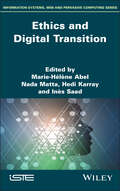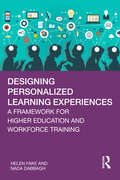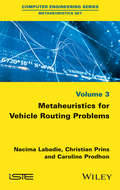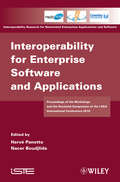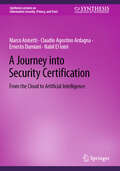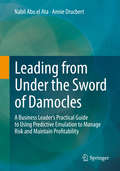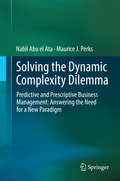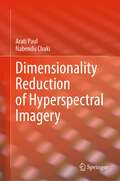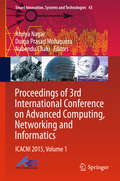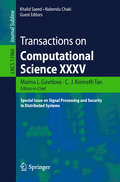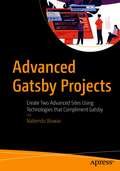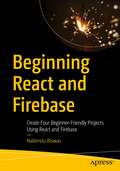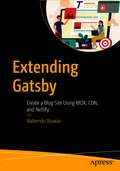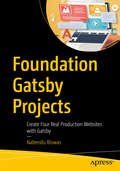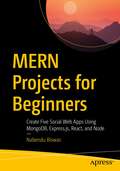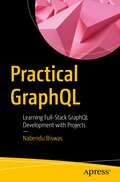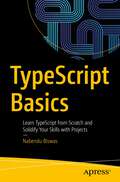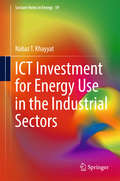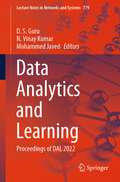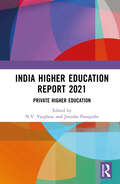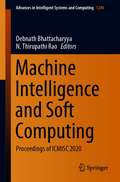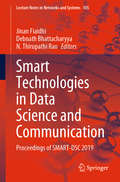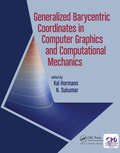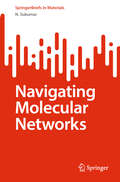- Table View
- List View
Ethics and Digital Transition (ISTE Invoiced)
by Nada Matta Inès Saad Hedi Karray Marie-Hélène AbelThis book presents a study carried out by the IEEE-SMC French chapter on ethics and digital transformation in industry and society. Based on a survey of researchers in ICT, artificial intelligence (AI), as well as on presentation seminars, this study examines the various aspects that should be considered when assessing ethical principles in approaches to digital transition, particularly with regard to intelligent systems. Considering this, Ethics and Digital Transition presents the main technologies and uses of intelligent systems. Bringing together specialists from various fields, it explores the different dimensions of ethics that should be considered in the development of these systems, from the engineering sciences to law, sociology and philosophy. It also looks at the future challenges of ethics in the digital transition.
Designing Personalized Learning Experiences: A Framework for Higher Education and Workforce Training
by Nada Dabbagh Helen FakeDesigning Personalized Learning Experiences offers theoretically grounded and pragmatic approaches to designing personalized learning initiatives for higher education and organizational contexts. With current research concluding that a multitude of variables can enable learners to direct their own experiences and achieve their goals, new guidance is needed to hone the range of instructional approaches, activities, and interactions available to support adult learners. This book offers practical strategies on how to design and implement effective personalized learning interventions, advance learning and engagement, encourage ownership over the learning process, and decrease attrition. Professionals in instructional design, learning and development, organizational development, consultancies, and beyond will be emboldened by the work to leverage a mix of technology-enabled social and content interactions.
Metaheuristics for Vehicle Routing Problems
by Nacima Labadie Caroline Prodhon Christian PrinsThis book is dedicated to metaheuristics as applied to vehicle routing problems. Several implementations are given as illustrative examples, along with applications to several typical vehicle routing problems. As a first step, a general presentation intends to make the reader more familiar with the related field of logistics and combinatorial optimization. This preamble is completed with a description of significant heuristic methods classically used to provide feasible solutions quickly, and local improvement moves widely used to search for enhanced solutions. The overview of these fundamentals allows appreciating the core of the work devoted to an analysis of metaheuristic methods for vehicle routing problems. Those methods are exposed according to their feature of working either on a sequence of single solutions, or on a set of solutions, or even by hybridizing metaheuristic approaches with others kind of methods.
Interoperability for Enterprise Software and Applications: Proceedings of the Workshops and the Doctorial Symposium of the I-ESA International Conference 2010
by Hervé Panetto Nacer BoudjlidaWithin the framework of the Sixth I-ESA International Conference, supported by the INTEROP VLab (International Virtual Laboratory on Enterprise Interoperability, http://www.interop-vlab.eu), three workshops and a Doctoral Symposium have been organized in order to strengthen some key topics related to interoperability for enterprise applications and software. The workshops were selected to complement the conference topics, leaving more time to researchers for brainstorming and then coming up, at the end of the workshops, with new research directions for the future. The goal of the workshop “Standards – a Foundation for Interoperability” is to increase awareness and understanding of interoperability standards as a fundamental need. The workshop “Use of MDI/SOA Concepts in Industry” promotes the application of MDI (Model-Driven Interoperability) combined with SOA (Services Oriented Architecture) and the associated technology (BPM, Enterprise Modeling, ontology, mediation, model transformation, etc.) in industry. The workshop on “Dynamic Management across Interoperating Enterprises” investigates the need for enhancements to current business management systems and processes to address the needs of global trading across enterprises utilizing the new service-oriented Internet. Finally, the Doctoral Symposium has given the opportunity for students involved in the preparation of their PhDs in this emerging area to present and discuss their research issues and ideas with senior researchers.
A Journey into Security Certification: From the Cloud to Artificial Intelligence (Synthesis Lectures on Information Security, Privacy, and Trust)
by Ernesto Damiani Claudio Agostino Ardagna Nabil El Ioini Marco AnisettiThis book, authored by some of the pioneers in the security certification domain, provides a foundational knowledge base for designing and deploying effective security certification schemes for cloud-edge distributed systems. It gives readers unique and essential insight into the history of security certification and its evolution from static to dynamic models. The book helps readers to understand the importance of security certification across distributed system evolution from cloud-based to artificial intelligence-machine learning systems. It covers in full the certification of cloud-based composite services, discussing the role of multi-factor certification. It also emphasizes processes for continuously certifying services across system and context changes, as well as the certification of the deployment environment and development process and their impact on the overall cloud service certification. The book considers and challenges existing security certification schemes for cloud services, discussing issues and gaps when applied to modern systems in the cloud-edge continuum and built on artificial intelligence. Readers will become familiar with the challenges in certifying cloud-edge distributed systems and machine learning-based systems. This book also provides actionable insight to readers who manage modern security systems. Security controls have grown in size and complexity, requiring reliable and sustainable certification schemes to support varying quality standards and produce compliant products. It covers the logic behind security standards and the evaluation criteria of main certification standards, further discussing the evolution and corresponding certification of distributed systems towards cloud, cloud-edge, and artificial intelligence. The book teaches readers how to build faster, scalable, and more reliable cloud-edge distributed systems and beyond.
Leading from Under the Sword of Damocles: A Business Leader's Practical Guide To Using Predictive Emulation To Manage Risk And Maintain Profitability
by Nabil Abu el Ata Annie DrucbertGlobalization trends and the rapid pace of technological innovations have introduced unprecedented change and uncertainty. For unprepared businesses, the drivers of the Fourth Industrial Revolution will become a constant source of surprise and crises will unfold at an ever-increasing rate. To thrive under these conditions, companies must adopt new risk management technologies and practices that enable business leaders to better anticipate and adjust to changing dynamics.This book helps readers understand how algorithm-based predictive and prescriptive analytics principles can be used to control risk in today’s dynamic business environment. It serves as a reference guide for business leaders and risk management practitioners of companies that are global in reach or operate dynamically complex systems. Using the technological and scientific innovations presented in this book, business leaders can gain a wider understanding of risk and prescriptively determine which actions are necessary to ensure the business is optimally positioned to meet its stated long-term goals and objectives.Case studies show how the presented methods can be practically applied to preemptively expose risks and support decisions to optimize, transform or disrupt current business models, strategies, organizational structure and information systems when necessary to maintain a market position or outperform competitors.These methods have been proven through hundreds of client cases. By using mathematical emulation to link business risks to strategic imperatives, it becomes possible to achieve a higher annual profit margin and better growth. As we enter the Fourth Industrial Revolution, companies that are able to expose risks caused by dynamic complexity and maintain the alignment between the goals of the business and operational execution will be better prepared to make the shifts necessary for long-term success and keep the business moving toward its goals.
Solving the Dynamic Complexity Dilemma
by Nabil Abu el Ata Maurice J. PerksDynamic complexity results from hidden, unknown factors--or more precisely, interactions between factors--that can unexpectedly impact the performance of systems. When the influences of dynamic complexity are not measured and understood, new never-seen-before behaviors can come as unwelcomed surprises, which disrupt the performance of systems. Left alone, processes that were once prized for their efficiency unexpectedly begin to degrade--costs increase, while volumes and quality decline. Evidence of problems may come too late for effective resolution as technology advancements induce rapid change and compress the time available to react to that change. The results of dynamic complexity are always negative and unmanaged dynamic complexity can bring business or global systems to the point of sudden chaos. The 2009 H1N1 pandemic, 2008 Credit Crunch and 2011 Fukushima Daiichi nuclear disaster are global examples of the dangers of undiagnosed dynamic complexity. With increasing frequency executive leaders today are discovering that their business and IT system performance levels are not meeting expectations. In most cases these performance deficiencies are caused by dynamic complexity, which lies hidden like a cancer until the symptoms reveal themselves--often when it is too late to avoid negative impacts on business outcomes. This book examines the growing business problem of dynamic complexity and presents a path to a practical solution. To achieve better predictability, organizations must be able to expose new, dangerous patterns of behavior in time to take corrective actions and know which actions will yield the optimal results. The book authors promote new methods of risk management that use data collection, analytics, machine learning and automation processes to help organizations more accurately predict the future and take strategic actions to improve performance outcomes. The presented means of achieving this goal are based upon the authors' practical experiences, backed by scientific principles, and results achieved through consulting engagements with over 350 global organizations.
Dimensionality Reduction of Hyperspectral Imagery
by Nabendu Chaki Arati PaulThis book provides information about different types of dimensionality reduction (DR) methods and their effectiveness in hyperspectral data processing. The authors first explain how hyperspectral imagery (HSI) plays an important role in remote sensing due to its high spectral resolution that enables better identification of different materials on the earth’s surface. The authors go on to describe potential challenges due to HSI being acquired in hundreds of narrow and contiguous bands, represented as a 3-dimensional image cube, often causing the bands to contain information redundancy. They then show how processing a large number of bands adds challenges in terms of computation complexity that reduces efficiency. The authors then present how DR is an essential step in hyperspectral data analysis to solve these issues. Overall, the book helps readers understand the DR processes and its impact in effective HSI analysis.
Proceedings of 3rd International Conference on Advanced Computing, Networking and Informatics
by Nabendu Chaki Durga Prasad Mohapatra Atulya NagarAdvanced Computing, Networking and Informatics are three distinct and mutually exclusive disciplines of knowledge with no apparent sharing/overlap among them. However, their convergence is observed in many real world applications, including cyber-security, internet banking, healthcare, sensor networks, cognitive radio, pervasive computing amidst many others. This two volume proceedings explore the combined use of Advanced Computing and Informatics in the next generation wireless networks and security, signal and image processing, ontology and human-computer interfaces (HCI). The two volumes together include 132 scholarly articles, which have been accepted for presentation from over 550 submissions in the Third International Conference on Advanced Computing, Networking and Informatics, 2015, held in Bhubaneswar, India during June 23-25, 2015.
Transactions on Computational Science XXXV: Special Issue on Signal Processing and Security in Distributed Systems (Lecture Notes in Computer Science #11960)
by Khalid Saeed Nabendu Chaki Marina L. Gavrilova C. J. Kenneth TanThe LNCS journal Transactions on Computational Science reflects recent developments in the field of Computational Science, conceiving the field not as a mere ancillary science but rather as an innovative approach supporting many other scientific disciplines. The journal focuses on original high-quality research in the realm of computational science in parallel and distributed environments, encompassing the facilitating theoretical foundations and the applications of large-scale computations and massive data processing. It addresses researchers and practitioners in areas ranging from aerospace to biochemistry, from electronics to geosciences, from mathematics to software architecture, presenting verifiable computational methods, findings, and solutions, and enabling industrial users to apply techniques of leading-edge, large-scale, high performance computational methods. This, the 35th issue of the Transactions on Computational Science, focusses on signal processing and security in distributed systems. The topics covered include classification of visual attention levels using microsaccades; analysis of textual content using Eyegaze; automatic car-accident detection and passenger counting; face recognition; secure data fusion in IoT; business compliance using goal models; and microfluidic executions.
Advanced Gatsby Projects: Create Two Advanced Sites Using Technologies that Compliment Gatsby
by Nabendu BiswasRoll your sleeves up and master advanced topics in Gatsby development by building two production-ready websites. This project-focused book teaches you how to use Gatsby alongside the latest technologies including Snipcart, and Firebase. It builds off of Foundation Gatsby Projects and it's recommended that you complete that first if you are new to Gatsby. In the first project, you will create a fully functional e-commerce site for a restaurant using Snipcart. Lastly, you’ll learn to build a recipe site using the Firebase database. Many Gatsby tutorials out there today only cover how to create a simple blog site – get ahead of the crowd using this book today. What You'll Learn Create an e-commerce site in no time using Snipcart with GatsbyWork with the Firebase database from Google in a Gatsby siteDeploy all sites in NetlifyAdd functionalities with the powerful Gatsby plugin ecosystem Who This Book Is For Anyone who wants to create a site using Gatsby, though knowledge of React and Gatsby is expected. You will need to be familiar with JavaScript concepts and be confident with basic web development. It is advisable to complete Foundation Gatsby Projects first if you have no Gatsby experience.
Beginning React and Firebase: Create Four Beginner-Friendly Projects Using React and Firebase
by Nabendu BiswasUse React with Firebase to build four beginner-friendly apps. A lot of React tutorials out there today only cover basic web apps, but with additional features the web apps included in this book can be converted into fully scaled startups. You will start with the basics: learn to deploy a React app with Firebase hosting. Next, you will learn to create a fully functional "ToDo" app that will use Firebase database to store a list action items. You will also learn to create a "Stories" app, in which you can show short vertical videos, and a document storage app. Here, we will be able to log in using Google Authentication, and will learn to store files in the app using Firebase storage. Lastly, you will create a career social media app. Your users will be able to log in using email and password authentication. You will learn to use Redux in this project.While creating these web apps, you will employ multiple concepts, including React hooks, React components, and how to use Material UI. You will learn to use Firebase to host your database, as well as hosting your app. With these projects in your portfolio you'll be ready to take your developer skills to the next level. What You'll Learn Use Firebase’s powerful services, and how to connect Firebase with ReactExplore the React ecosystem, including Redux and React hooksWork with MaterialUI, the popular React UI frameworkUnderstand how to use Google Authentication techniques in your sitesDeploy all sites using simple Firebase hosting Who This Book Is For Developers at the beginning of their career, or anyone who wants to take their React skills to the next level.
Extending Gatsby: Create a Blog Site Using MDX, CDN, and Netlify
by Nabendu BiswasExpand your Gatsby development skills by building a production-ready blog website. This book teaches you how to use Gatsby alongside the latest technologies including MDX, CDN, and Netlify. In this project, you will create a very complex and large blog site with just MDX files and learn to optimize images using CDN for faster website loading. You will also learn to continuously deploy to Netlify enabling you to provide daily site updates easily. To get the most out of this book you should be comfortable with the basics of React and familiar with Gatsby fundamentals as covered in Foundation Gatsby Projects, which provides several stepping stone projects. Rather than cover how to create a simple blog site, Extending Gatsby goes beyond the basics to extend your blogging skills. What You'll Learn Develop a production-ready, complex, blogging system site with MDXLearn to make a complete mobile siteContinuously deploy your site using NetlifyAdd functionalities with the powerful Gatsby plugin ecosystem Who This Book Is For This book is for developers who are familiar with Gatsby and are looking to create an extended blog site. Knowledge of React is expected. You will also need to be familiar with JavaScript concepts and be confident with basic web development.
Foundation Gatsby Projects: Create Four Real Production Websites with Gatsby
by Nabendu BiswasEnhance your Gatsby skillset by building a series of ready-to-use web sites. With the aid of four projects, this book teaches you how to use Gatsby alongside the latest technologies, including Contentful, Twillio, and Stackbit. In the first project, you will create a simple agency site with a contact form and deploy it to Netlify. You'll then quickly be able to create other basic client sites. Next, you will learn to set up a blog site using Stackbit and Dev CMS. Other projects include a large site built with Contentful and a video chat using Twilio. Many Gatsby tutorials out there today only cover how to create blog sites – get ahead of the crowd using this book today. What You'll Learn Use Contentful CMS with GatsbyBuild sites quickly with Stackbit serviceDevelop a video chat site similar to Skype with Twilio services Deploy all sites in NetlifyAdd functionalities with the powerful Gatsby plugin ecosystem Integrate advertisements Who This Book Is For Anyone who wants to create a site using Gatsby. A little knowledge of React is expected but is not a necessity. You will need to be familiar with JavaScript concepts and be confident with basic web development.
MERN Projects for Beginners: Create Five Social Web Apps Using MongoDB, Express.js, React, and Node
by Nabendu BiswasLearn how to use the MERN stack (MongoDB, Express.js, React, and Node) to build five fully functioning web apps for dating, video sharing, messaging, and social media. While creating these web apps, you’ll learn key development concepts including how to use React hooks, Redux, MongoDB, Express, Heroku, Firebase, Material UI, and Google authentication. By expanding your portfolio with the projects you create, you will be well equipped as front-end developer. You will first create a dating site with a swiping feature and chat functionality. You will then build a video sharing app with videos displaying vertically. Next, you will learn to build an awesome messaging web app. Users will be able to chat in real time, as well as log in to their account using Google authentication. You will also create a photo sharing app and social media web apps with the ability to post images with captions and log in using email and password authentication. Most MERN tutorials out there today cover basic web apps but it is capable of so much more – learn how to use this stack to its full potential and build projects that can be converted into full scaled start-ups with additional features. What You'll LearnWork with React hooks and React routerExamine powerful MongoDB services for easy to use and setupCreate routes using Node and host on HerokuStudy different authentication techniquesDeploy all sites using simple Firebase hostingUse the powerful React ecosystem to add functionalities to your apps Who This book Is For Those who have just started their career in web development and have basic knowledge of the core web technologies: HTML, CSS, and JavaScript. Those with basic React development and feel ready to explore its capabilities further.
Practical GraphQL: Learning Full-Stack GraphQL Development with Projects
by Nabendu BiswasMaster the query language that is revolutionizing how websites are developed and built. This book is a hands-on guide to GraphQL, and will teach you how to use this open source tool to develop and deploy applications quickly and with minimal fuss.Using a project-based approach, you'll learn how to use GraphQL from the ground up. You'll start with the basics, including set up and key details regarding queries and mutations, before moving on to more advanced topics and projects. Over the course of the book, you will gain a thorough understanding of the web development ecosystem from frontend to backend by building React applications using Prisma Apollo Client and MongoDB.After completing this book, you'll be equipped with the knowledge and skills needed to turbo charge your own enterprise projects.What You'll LearnUnderstand what GraphQL is and how to use itDistinguish between queries and mutations, and how to leverage themGain a greater knowledge of full-stack applications with React, Apollo Server, and Apollo ClientCreate a full stack application with React and PrismaWho This Book Is ForDevelopers and engineers who want to learn about GraphQL so that they can implement in their enterprise React projects. This book is aimed at both backend developers and full stack developers who want to learn to create backend queries using GraphQL.
TypeScript Basics: Learn TypeScript from Scratch and Solidify Your Skills with Projects
by Nabendu BiswasJumpstart your working knowledge of Typescript with a quick, practical guide and start using this open source, object orientated language with confidence. This book highlights how Typescript works with JavaScript and its frameworks, giving it greater functionality, especially for larger enterprise projects. You'll start by reviewing some fundamentals such as how to run a TypeScript file and compile it to JavaScript as well as understand how it sits within the full ecosystem alongside React, Redux, Angular and Webpack. Using a practical project-led approach, you'll go through key concepts and aspects of Typescript such as compilers, arrays, classes and interfaces. Once you complete the fundamental basics, you'll move onto more complex topics like advanced types. You'll also learn about Decorators, which are a must-have feature in Angular. The book then presents a small To-do list project followed by a larger 'Drag and Drop' project. You'll see how to divide the drag and drop project into small manageable modules and learn to make the project more efficient with Webpack. Lastly, you'll create two more React projects, a party app with React and then one with React and Redux. Typescript Basics reveals how this JavaScript extension is currently the fastest growing language for web development with more and more developers and companies looking to utilize and adopt it within their current workflows and projects. What You'll LearnUnderstand the particulars of Typescript and how it feeds into the JS and Web development eco-systemImplement Typescript for enterprise projectsUse Typescript with practical projects and examplesSee how Typescript interacts with major frameworks like React and Angular Who This Book Is ForThose who want to learn about TypeScript and implement it in their Enterprise or hobby projects with React and Angular. Beginners will find it easy to learn the basic concepts and principles to get started and to progress onto more advanced projects and how to implement them.
ICT Investment for Energy Use in the Industrial Sectors
by Nabaz T. KhayyatThis book investigates the impact of production input factors on the market, consumer and producer energy demand characteristics in 30 industrial sectors for South Korea over the period 1980-2009, and for Japan over the period 1973-2006, with special emphasis placed on the effects of ICT investment on the demand for energy. A dynamic factor demand model is developed, accounting for the adjustment costs that are defined in terms of forgone output from current production. It addresses four key aspects of production and energy demand in manufacturing: first, it establishes the various relationships between different factors of production. Second, it investigates whether the energy demand in the industrial sectors in South Korea would be decreased or increased by substituting/complementing with other input factors such as ICT capital and labor. Third, it looks at sources of growth in the industrial sectors through decomposing the Divisia index based total factor productivity (TFP). Finally it provides appropriate policy recommendations based on these findings. The results of this study may provide industrial sectors' stakeholders and environmental and industrial policy makers with a flexible model that has the capacity to assess outcomes of various policies under certain scenarios. The factor demand methodology described in this book is very advanced and up-to-date. It can be used when teaching advanced graduate courses and in empirically advanced research. Therefore, it is highly relevant in both teaching as a main or supplementary text and in particular as a reference handbook in conducting empirical research. The focus on ICT effects on energy use makes this book an important addition to the existing literature on industrial development.
The Unpredictable Certainty: Information Infrastructure Through 2000
by NII 2000 Steering CommitteeWe have available an impressive array of information technology. We can transmit literature, movies, music, and talk. Government, businesses, and individuals are eager to go on-line to buy, sell, teach, learn, and more. How, then, should we go about developing an infrastructure for on- line communication among everyone everywhere? The Unpredictable Certainty explores the national information infrastructure (NII) as the collection of all public and private information services. But how and when will the NII become a reality? How will more and better services reach the home, small businesses, and remote locations? The Unpredictable Certainty examines who will finance the NII, exploring how technology companies decide to invest in deployment and the the vain search for "killer apps" (applications that drive markets). It discusses who will pay for ongoing services and how they will pay, looking at past cost/price models relevant to the future. The Unpredictable Certainty discusses the underlying technologies, appliances, and services needed before the NII becomes a reality; reviews key features of important technologies; and analyzes current levels of deployment in telephone, cable and broadcast television, and wireless systems, and the difficulties in interconnection. The volume explores the challenge of open interfaces that stimulate new applications but also facilitate competition, the trend toward the separation of infrastructure from specific services, the tension between mature services and new contenders, the growth of the Internet, and more. The roles governments at different levels might play in fostering NII deployment are outlined, including R&D and the use of information infrastructure for better delivery of government services and information.
Data Analytics and Learning: Proceedings of DAL 2022 (Lecture Notes in Networks and Systems #779)
by D. S. Guru N. Vinay Kumar Mohammed JavedThis book presents new theories and working models in the areas of data analytics and learning. The papers included in this volume were presented at the second International Conference on Data Analytics and Learning (DAL 2022), which was organized by the Department of Computer Science & Engineering, Alva’s Institute of Engineering & Technology, Moodbidri, Mangalore, Karnataka, India in association with the Department of Studies in Computer Science, University of Mysore, Mysuru, Karnataka, India. The areas covered include pattern recognition, image processing, deep learning, computer vision, data analytics, machine learning, artificial intelligence, and intelligent systems.
India Higher Education Report 2021: Private Higher Education
by N. V. Varghese Jinusha PanigrahiThis volume provides an in-depth analysis of the critical dimensions of higher education in India. It focuses on the growth and expansion of private higher education and public policy. The volume discusses issues related to the growth of for-profit and not-for-profit private higher education institutions and their implications at the policy level. It outlines the role of such institutions towards the internationalization and global ranking of the Indian higher education system. The book discusses the trends in internationalisation adopted by private higher education institutions and explains the resulting impact on aspects such as the diversity of programs, skill formation, employability, pedagogic practices, standards, curriculum development, and research and development, as well as the wider externalities in terms of promoting India’s soft power and international relations with other countries. While outlining the challenges of Open Distance Learning (ODL) and online education in India, the book also discusses the use of ICT, OER, and MOOCS among others to address the challenges of the ODL system. This volume will be of interest to teachers, students, and researchers of education, public policy, political science, international relations, law, sociology, economics, and political economy. It will also be useful for academicians, policymakers, and anyone interested in the internationalization of Indian Higher Education.
Machine Intelligence and Soft Computing: Proceedings of ICMISC 2020 (Advances in Intelligent Systems and Computing #1280)
by Debnath Bhattacharyya N. Thirupathi RaoThis book gathers selected papers presented at the International Conference on Machine Intelligence and Soft Computing (ICMISC 2020), held jointly by Vignan’s Institute of Information Technology, Visakhapatnam, India and VFSTR Deemed to be University, Guntur, AP, India during 03-04 September 2020. Topics covered in the book include the artificial neural networks and fuzzy logic, cloud computing, evolutionary algorithms and computation, machine learning, metaheuristics and swarm intelligence, neuro-fuzzy system, soft computing and decision support systems, soft computing applications in actuarial science, soft computing for database deadlock resolution, soft computing methods in engineering, and support vector machine.
Smart Technologies in Data Science and Communication: Proceedings of SMART-DSC 2019 (Lecture Notes in Networks and Systems #105)
by Jinan Fiaidhi Debnath Bhattacharyya N. Thirupathi RaoThis book features high-quality, peer-reviewed research papers presented at the International Conference on Smart Technologies in Data Science and Communication (Smart-DSC 2019), held at Vignan’s Institute of Information Technology (Autonomous), Visakhapatnam, Andhra Pradesh, India on 13–14 December 2019. It includes innovative and novel contributions in the areas of data analytics, communication and soft computing.
Generalized Barycentric Coordinates in Computer Graphics and Computational Mechanics
by N. Sukumar Kai HormannIn Generalized Barycentric Coordinates in Computer Graphics and Computational Mechanics, eminent computer graphics and computational mechanics researchers provide a state-of-the-art overview of generalized barycentric coordinates. Commonly used in cutting-edge applications such as mesh parametrization, image warping, mesh deformation, and finite as well as boundary element methods, the theory of barycentric coordinates is also fundamental for use in animation and in simulating the deformation of solid continua. Generalized Barycentric Coordinates is divided into three sections, with five chapters each, covering the theoretical background, as well as their use in computer graphics and computational mechanics. A vivid 16-page insert helps illustrating the stunning applications of this fascinating research area. <P><P>Key Features: <li>Provides an overview of the many different types of barycentric coordinates and their properties. <li>Discusses diverse applications of barycentric coordinates in computer graphics and computational mechanics. <li>The first book-length treatment on this topic
Navigating Molecular Networks (SpringerBriefs in Materials)
by N. SukumarThis book delves into the foundational principles governing the treatment of molecular networks and "chemical space"—the comprehensive domain encompassing all physically achievable molecules—from the perspectives of vector space, graph theory, and data science. It explores similarity kernels, network measures, spectral graph theory, and random matrix theory, weaving intriguing connections between these diverse subjects. Notably, it emphasizes the visualization of molecular networks. The exploration continues by delving into contemporary generative deep learning models, increasingly pivotal in the pursuit of new materials possessing specific properties, showcasing some of the most compelling advancements in this field. Concluding with a discussion on the meanings of discovery, creativity, and the role of artificial intelligence (AI) therein.Its primary audience comprises senior undergraduate and graduate students specializing in physics, chemistry, and materials science. Additionally, it caters to those interested in the potential transformation of material discovery through computational, network, AI, and machine learning (ML) methodologies.
